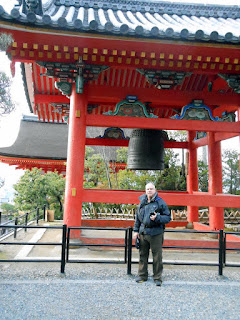There are 17 properties in the Historic Monuments of
Ancient Kyoto designation including three we visited on this trip.
Kiyomizu-dera
Established in 778, this temple has continuously attracted
worshippers from among the populace since the Heian Period as
"Kiyomizu-Kannon." The temple contains buildings from the 15th to
17th centuries, including Jishu - jinja Shrine. The Main Hall (Hondo), built in
the "stage" style, is noted for its beautiful background scenery
which changes with the four seasons - including the cherry blossoms and greenery
of spring, and the leaves of autumn. Built atop a precipice, the main hall,
which is a National Treasure, is famous as the "Kiyomizu Stage" -
affording a magnificent view of the city below. The temple precincts contain
fifteen buildings designated as Important Cultural Properties, including the
inner Temple (Okunoin), Amida Buddha Hall (Amidado), and the three-tiered
pagoda.Built by Ashikaga Yoshimasa as a mountain villa in 1482, Jishoji Temple was later converted into a temple. Officially named Jisho - ji Temple, this temple is a great example of Higashiyama culture. The Ginkaku, or "Silver Pavilion," with its simple, noble design, is a National Treasure. It is also known as Kannon-dono (Kannon Palace). Togudo (Buddha Hall), also a National Treasure, is a relic of early shoin-zukuri, or library style. In the garden (designated as a special place of scenic beauty) are the so-called "Sea of Silver Sand" and the "Moon Platform," from which the light of the moon is said to reflect and shine on the Silver Pavilion.
To-Ji
Constructed as Toji Temple (literally, "East Temple")
to protect the nation at the time of the establishment of Heian-kyo, this
temple was converted by Kukai into a seminary of the Shingon sect (Esoteric
Buddhism). In addition to the temple, which dates back to the Heian Period,
Kyo-o-gokokuji Temple contains buildings dating from the 14th to 17th
centuries. The Lecture Hall (Kodo) houses the oldest extant Esoteric Buddhist
statues in Japan. The five-tiered pagoda, a National Treasure, rises above the
landscape as a symbol of Kyoto. With a height of 57 meters, it is the tallest
pagoda in Japan.
Nakijin Castle
ruins
The Nakijin-jô (Nakijin Castle) became the residence of
the Ryukyuan Kingdom governor. Work began on its construction in the late 13th
century and it had reached its final form by the beginning of the 15th century.
The castle is strategically sited on a lone hill, well defended by natural
features (river, cliffs and deep valley).Shuri-jô (Shuri Castle) built in the second half of the 14th century, was the main castle of the kings of Chûzan and, after unification, of the Ryukyu Kingdom. The hill on which it stands dominates Naha City and its port. It is divided into inner and outer enclosures, conforming with the topography. The castle's enclosure walls, built with random bonding of coralline limestone, extend over 1,080 m.
Stone Gate of the
Sonohyan Shrine
The Sonohyan-utaki Ishimon (Stone Gate of the Sonohyan
Shrine) was erected in 1519 by Shô Shin, fronting a sacred forest
(Sonohyan-utaki). It was considered to be the guardian shrine of the Ryukyu
Kingdom, where prayers were offered for peace and security at annual ritual
ceremonies. It represents the unique style of stone architecture developed in
Ryukyu.
Tamaudun Tomb
The Tamaudun Royal was built by Shô Shin around 1501 as a
symbol of royal power, and to take advantage of the Ryukyuan people's practice
of worshipping at the tombs of ancestors. It is carved into the limestone
bedrock and covered by a gabled pantile roof.
Shikinaen Garden
Shikinaen, a royal garden villa, is recorded as having
been constructed in 1799. The plan shows Japanese influence, although Chinese
features are to be found in some structures. The result is, however, uniquely
Ryukyuan. Around the pool are disposed walkways, pavilions, artificial hills
and flower gardens.
(On our trip last year we visited Kinkaku-ji and Nijo
Castle in Kyoto and Tôdai-ji Temple in
Nara).









































1 comment:
Awesome! It's cool to see your travels in Okinawa. Like you, I'm a big World Heritage fan and am still trying to see all 17 sites in Kyoto!
Post a Comment